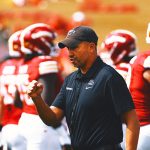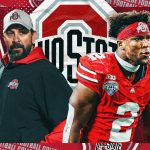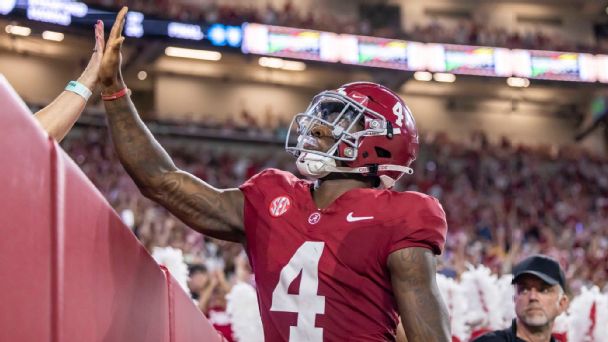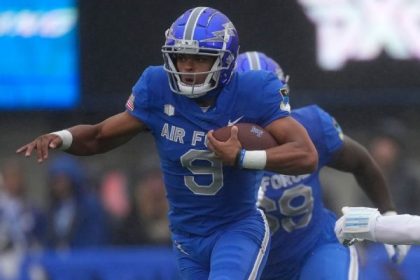
By now, you know Deion Sanders has taken over the college football universe after his unique transfer-heavy Colorado roster upset TCU in his first game as an FBS coach.
But there were plenty of other items of significance that transpired in Week 1, including new quarterbacks in high-profile places, some offensive surprises in the Big Ten and another roster upheaval that paid dividends amid considerably less fanfare.
Here are the biggest takeaways from the season’s opening weekend by our college football reporters.

Milroe shows his upside, but questions remain
0:36
Jalen Milroe turns fumbled snap into 21-yard TD
Jalen Milroe shows his skills after recovering a fumbled snap and rushing for a 21-yard touchdown.
Alabama quarterback Jalen Milroe brought out the whole arsenal against Middle Tennessee, showing off his scrambling ability as well as his strong arm. His first touchdown, when he scooped up an errant snap and ran 21 yards into the end zone, was special. You can’t teach that type of playmaking ability. And his two long touchdown passes — one 47 yards just before halftime, another 48 yards coming out of the half — were picture perfect. It was enough to make you wonder why there was a quarterback competition in the first place.
But it’s important to remember there was a reason behind it. The question has never been about Milroe’s physical gifts, it’s whether he can consistently make good decisions and the kind of reads and progressions in the pocket that are required against quality defenses. Let’s face it: For as solid as Middle Tennessee is (the Blue Raiders won eight games last year), it doesn’t have the caliber of athletes that Alabama will see the rest of the season. So while it’s as good a start as Milroe could have possibly hoped for, it’s probably not the end of the quarterback competition. We’ll learn much more Saturday against Texas. — Alex Scarborough
Ohio State has an offensive learning curve
While Colorado and TCU kicked things off with offensive fireworks, nothing came easy for Ohio State’s offense and first-year starting quarterback Kyle McCord. The Buckeyes did what they were supposed to do and beat an unranked Indiana team on the road, but they hardly looked ready to contend for the national title. Instead, they looked like a team with three new starting offensive linemen and a rookie quarterback. Indiana’s defense, which ranked last in the Big Ten last year, was respectable and limited projected first-round NFL draft pick Marvin Harrison Jr. to just two catches for 19 yards. There were times McCord moved the ball well, and he had some perfectly placed throws, but there were also several missed opportunities and one interception when he threw it across his body.
Backup Devin Brown played only two series, throwing just three passes, so it’s still unclear how much he can or will contribute. With a strong running game, a plethora of talented receivers and an established go-to option in tight end Cade Stover, this is an offense that should only get better. It has to do it quickly, though. Ohio State travels to Notre Dame on Sept. 23 in a game that will have CFP implications — just like it did last year. — Heather Dinich
Michigan shows some balance
Quarterback J.J. McCarthy put in extra work this offseason to put on weight and hone his skills in the passing game, and that work was evident Saturday. McCarthy has said his shoulder is fully healed and he feels free and comfortable throwing the ball. McCarthy completed 26 of 30 passes for 280 yards and three touchdowns in the season-opening 30-3 win over East Carolina.
The Pirates loaded up the box to stop the run, which has been Michigan’s bread and butter under Jim Harbaugh, but Michigan was able to beat them through the air. Michigan’s explosive running back duo, Blake Corum and Donovan Edwards, combined for 110 yards rushing and one touchdown on the day. If the passing game continues to develop, Michigan will have a more balanced and less predictable offense. That will pay off if the Wolverines make it back to the College Football Playoff. — Tom VanHaaren
Strong start to Penix’s Heisman campaign
0:39
Polk’s big-time catch sets up Penix’s 5th passing TD
Michael Penix Jr. airs it out to Ja’Lynn Polk, then finds Rome Odunze for his fifth passing touchdown of the game.
When he finished eighth in the Heisman Trophy voting last year, Washington quarterback Michael Penix Jr.’s season high for touchdown passes was four. He tossed five against Boise State on Saturday, to go along with 450 yards passing in a statement 56-19 win.
We know this about Penix: He’s going to put up massive numbers. He threw for 4,641 yards last season with 31 touchdown passes, and this year’s offense should be better. It shouldn’t surprise anyone if he cracks 5,000 yards. That’ll keep him in the Heisman mix on its own, but for him to have a serious shot at winning, of course, the Huskies will need to pile up the Ws. He’ll have a good shot to put up some more big numbers next week against Tulsa before an interesting test at Michigan State on Sept. 16. — Kyle Bonagura
Tennessee‘s defense steals the show
With so much hype surrounding quarterback Joe Milton III this offseason (and his 2023 debut was impressive), perhaps the most encouraging thing for Tennessee in its 49-13 win over Virginia was the defense. Granted, the Cavaliers were depleted in the offensive line, but the Vols’ defense looked faster, more aggressive and more equipped to make plays in the open field than a year ago. They finished with 11 tackles for loss, and 10 players were credited with at least a half-tackle for loss.
Some newer, less-proven names emerged. Sophomore James Pearce Jr. had two third-down sacks in the first half, and with his 6-foot-5, 245-pound frame, he has everything it takes to be an impact edge rusher. Getting more pressure with its four-man front will be a key for Tennessee, and the Vols showed signs of doing that Saturday. Again, there will be tougher tests along the way. We know Josh Heupel’s team will score, but dating back to the end of last season, defensive coordinator Tim Banks’ unit has held its last three opponents to 14 or fewer points. — Chris Low
UCLA is unofficially Dante Moore’s team now
Chip Kelly might not admit it, but it might have taken true freshman quarterback Dante Moore only one game, 12 throws and two touchdowns to show his coach (and everyone else) why he should be the starter. UCLA’s QB battle resulted in the naming of a quasi-starter — last year’s backup Ethan Garbers — and two alternative options (Collin Schlee and Moore) whom Kelly said would play in the season opener. This pseudo quarterback-by-committee plan didn’t last even one game.
Against Coastal Carolina, Garbers struggled with two interceptions, Schlee didn’t play and Moore immediately injected the Bruins’ offense with some pop. In the third quarter, with UCLA holding on to a one-point lead after having two drives end in an interception and a punt, Moore entered the game and, on the first play, threw for a 62-yard touchdown that helped fuel UCLA’s 27-13 win. The 19-year-old did throw an interception in a key spot near the end zone, but any growing pains look to be a risk worth taking given Moore’s upside. After the game, Kelly said both quarterbacks played well and that neither stood out more than the other. Yes, Kelly has to manage the possibilities and personalities of his quarterback room; the tape, however, won’t lie. — Paolo Uggetti
Texas State another quick-fix transformation
In college football history, there has never been a roster transformation like Deion Sanders undertook this offseason. Just 10 scholarship players returned. There were 86 new faces all blended together in Sanders’ first FBS job. Last season, the Buffaloes went 1-11 and lost by an average of 29.1 points per game. Game 1 was against TCU, last year’s Cinderella story, in front of a record crowd. The result: A 45-42 upset of the No. 17 Horned Frogs after coming in as 21-point underdogs.
But a lesser-known reinvention happened at Texas State, where first-year coach G.J. Kinne brought in 53 newcomers, second most in the country only to Colorado. The Bobcats have played a Power 5 team 11 times in school history, going winless while being outscored by an average of 27.8 points. Kinne’s debut game was against Baylor, who beat the Bobcats 42-7 last season. On Saturday, Texas State, 26.5-point underdogs, throttled Baylor 42-31.
The approach, met with a great deal of skepticism, will raise a lot of eyebrows. Is the era of the quick-fix roster turnover upon us for good? — Dave Wilson
Dawgs’ ‘slow start’ doesn’t concern Smart
Georgia‘s slow start on offense in its 48-7 victory over FCS program UT-Martin left some fans already second-guessing new quarterback Carson Beck and offensive coordinator Mike Bobo. The Bulldogs led 17-0 at the half and added two touchdowns in the third quarter to pull away. Beck, who replaced Stetson Bennett, completed 21 of 31 passes for 294 yards with two touchdowns (one rushing). Georgia piled up 559 yards of offense, including 400 passing. The Bulldogs played without receivers Ladd McConkey and Marcus Rosemy-Jacksaint and tailback Daijun Edwards. The rebuilt offensive line had two new starting tackles. Georgia wasn’t explosive in the running game.
“Everybody thinks you’re just going to walk out there and roll over these teams,” Georgia coach Kirby Smart said. “‘Oh, it oughta be 40-to-nothing by halftime.’ And then it’s not and guys get worried. I’m not. I’m past that. I want to grow and get better.” Georgia will play another nonconference game against Ball State next week to try to do just that. — Mark Schlabach











